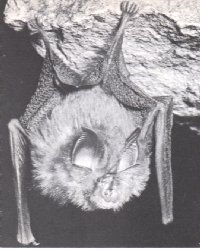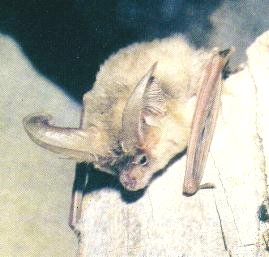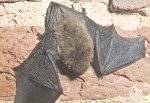Maltese Chiroptera
(including fossil forms)
This order of mammals is no doubt one of the
most difficult to study because of the difficulty of finding specimens
for correct identification. The list of species below is far from complete
or correct and a number of reported species may have been incorrect identifications
or rare migrants. A number of fossil chiroptera species have also been
described from the deposits at Ghar Dalam Cave at Birzebbugia (Malta).
SYSTEMATIC LIST OF REPORTED MALTESE CHIROPTERA SPECIES
Order: CHIROPTERA Blumenbach 1774
Sub-Order: MICROCHIROPTERA Dobson 1875
Family: RHINOLOPHIDAE Bell 1836
Genus: Rhinolophus
This genus appears to be represented by a number of species, though
some records may be mistaken identifications. The present author has confirmed
only the species R. hipposideros.
Rhinolophus hipposideros (Bechstein)
Lesser Horseshoe Bat
maltese: Farfett il-Lejl tan-Nala Zghir
 Reported
by a number of authors including Gav. Gulia (1890), Giov. Gulia (1913),
B. Lanza (1959), F.H. Van der Brink (1967), G. Lanfranco (1969), C. Savona-Ventura
(1984) and Lanfranco & Schembri, 1989) who considered it vulnerable
locally. The species has also been described from all the layers (early-late
Quaternary deposits and prehistoric-recent deposits) of the Ghar Dalam
Cave floor (G. Storch, 1974).
Reported
by a number of authors including Gav. Gulia (1890), Giov. Gulia (1913),
B. Lanza (1959), F.H. Van der Brink (1967), G. Lanfranco (1969), C. Savona-Ventura
(1984) and Lanfranco & Schembri, 1989) who considered it vulnerable
locally. The species has also been described from all the layers (early-late
Quaternary deposits and prehistoric-recent deposits) of the Ghar Dalam
Cave floor (G. Storch, 1974).
Rhinolophus ferrumequinum (Schreber)
Greater Horseshoe Bat
maltese: Farfett il-Lejl tan-Nala kbir
 Reported
by a number of authors including B. Lanza (1959), F.H. Van der Brink (1967),
G. Lanfranco (1969) and G. Lanfranco & P.J. Schembri (1989) who considered
it very rare.
Reported
by a number of authors including B. Lanza (1959), F.H. Van der Brink (1967),
G. Lanfranco (1969) and G. Lanfranco & P.J. Schembri (1989) who considered
it very rare.
Rhinolophus blasii Peters
Blasius' Horseshoe Bat
Reported only by Gav. Gulia (1890) who based his record on an observation
made in 1871. Record repeated by his son Giov. Gulia (1913). Lanfranco
(1969) believed this record to be a mistaken identification. This species
was described in the early and late Quaternary deposits at Ghar Dalan Cave
(G. Storch, 1974).
Rhinolophus euryale Blasius
Euryale's Horseshoe Bat
This species has been reported from the late quaternary and prehistoric
deposits of Ghar Dalam Cave (G. Storch, 1974).
Rhinolophus mehelyi Matschie
Mehelyi's Horseshoe Bat
This species has been reported from the early and late quaternary
deposits of Ghar Dalam Cave. (G. Storch, 1974). The remains from the early
quaternary deposits have been assigned to an endemic subspecies birzebbugensis
Storch. While the species is still found in Europe, the subspecies birzebbugensis
represents an extinct form which could have represented a member of the
evolutionary line to the recent form.
SPECIES............Recent..Prehistoric...Late Quaternary...Early
Quat.
R. hipposideros......*..........*..............*...............*
R. ferrumequinum.....*..........................................
R. blasii......................................*...............*
R. mehelyi.....................................*...............*
R. euryale......................*..............*................
Family: MOLOSSIDAE Gill 1872
Tadarida teniotis (Rafinesque)
European free-tailed Bat
Recorded from the Maltese Islands by J.J. Borg (1994, 1996).
Family: VESPERTILLIONIDAE Gray 1821
Sub-family: MINIOPTILIONIDAE Miller 1907
Miniopterus schreibersi (Natterer in Kuhl)
Schreiber's Bat
maltese: Farfett il-Lejl ta' Xrajber
Recorded by F.H. Van der Brink (1967), G. Lanfranco (1969) and G.
Lanfranco & P.J. Schembri (1989) who considered it rare locally. The
species was also recorded from the early and late quaternary deposits at
Ghar Dalam Cave (G. Storch, 1974).
Sub-family: VESPERTILIONIDAE Miller 1897
Plecotus auritus (Linnaeus)
Long-eared Bat
maltese: Farfett il-Lejl tal-Widnejn kbar
 Reported
by a number of authors including A.L. Adams (1870), Gav. Gulia (1890),
Giov. Gulia (1913), B. Lanza (1959), F.H. Van der Brink (1967), G. Lanfranco
(1969) and G. Lanfranco & P.J. Schembri (1989) who considered it vulnerable
locally.
Reported
by a number of authors including A.L. Adams (1870), Gav. Gulia (1890),
Giov. Gulia (1913), B. Lanza (1959), F.H. Van der Brink (1967), G. Lanfranco
(1969) and G. Lanfranco & P.J. Schembri (1989) who considered it vulnerable
locally.
Nyctalus noctula (Schreber)
Noctule
maltese: noktula
 Recorded as
being possibly a migrant coming to Malta around autumn by G. Lanfranco
(1969) and G. Lanfranco & P.J. Schembri (1989) who considered it very
rare locally.
Recorded as
being possibly a migrant coming to Malta around autumn by G. Lanfranco
(1969) and G. Lanfranco & P.J. Schembri (1989) who considered it very
rare locally.
Vespertilio (vespertilio) murinus Linnaeus
Recorded by B. Lanza (1959), G.S. Miller (1912), G. Stroch (1974).
Vespertilio (eptesicus) serotinus (Schreber)
Serotine Bat
maltese: serotin
 A number of
specimens of this species were recorded by G. Lanfranco (1969) and G. Lanfranco
& P.J. Schembri (1989) who considered it very rare locally.
A number of
specimens of this species were recorded by G. Lanfranco (1969) and G. Lanfranco
& P.J. Schembri (1989) who considered it very rare locally.
Vespertilio (eptesicus) praeglacialis Kormos
This species identified in the early quaternary deposits of Ghar
Dalam Cave represents a evolutionary line leading to V. serotinus
(G. Sortch, 1974).
Pipistrellus pipistrellus (Schreber)
Pipistrelle
maltese: pipistrell
 This species
is common in Malta, and has been recorded by B. Lanza (1959), G. Lanfranco
(1969), the present author and G. Lanfranco & P.J. Schembri (1989)
who considered it vulnerable locally. It has also been described in Gozo
(S.P. Schembri, 1981) and Comino (C. Savona-Ventura, 1984a). The species
was also reported from the early quaternary deposits of Ghar Dalam Cave
(G. Storch, 1974).
This species
is common in Malta, and has been recorded by B. Lanza (1959), G. Lanfranco
(1969), the present author and G. Lanfranco & P.J. Schembri (1989)
who considered it vulnerable locally. It has also been described in Gozo
(S.P. Schembri, 1981) and Comino (C. Savona-Ventura, 1984a). The species
was also reported from the early quaternary deposits of Ghar Dalam Cave
(G. Storch, 1974).
Pipistrellus kuhlii (Natteri in Kuhl)
Kuhl's Pipistrelle
maltese: Pipistrell ta' Kuhl
Recorded as rare by Gav. Gulia (1890), Giov. Gulia (1913), the record
being repeated by G. Lanfranco (1969) and G. Lanfranco & P.J. Schembri
(1989) who considered it rare locally.
......SPECIES..............Recent...Prehist....Late Quat...Early
Quat.
Tadarida teniotis............*..................................
Miniopterus schreibersi......*....................*............*
Plecotus auritus.............*..................................
Nyctalus noctula.............*..................................
Vespertilio murinus..........*..................................
Vespertilio serotinus........*..................................
Vespertilio praeglacialis......................................*
Pipistrellus pipistrellus....*.................................*
Pipistrellus kuhli...........*..................................
Genus: MYOTIS KAUP 1829
This genus has been reported to be represented by a number of species.
A statistical analysis of a number of specimens have confirmed only one
species M. blythi whose average measurements appeared to be intermediate
between m. myotis and m. blythis oxygnathus (C. Savona-Ventura,
1984b). This has been attributed to the species m. blythis punicus
(Lanfranco & Schembri 1989)
Myotis (leucone) daubentoni (Leisier)
Daubenton's Bat
Reported as not very rare by Gav. Gulia (1890) and as rare by Giov.
Gulia (1913). B. Lanza (1959) believed the record to be doubtful, a view
maintained by G. Lanfranco (1969) and C. Savona-Ventura (1984b) who suggested
that this may be rare migrant.
Myotis (leucone) capaccini (Bonaparte)
Long-fingered Bat
Reported as rare by Gav. Gulia (1870) and Giov. Gulia (1913). B.
Lanza (1959) believed the record to be doubtful, a view maintained by G.
Lanfranco (1969) and C. Savona-Ventura (1984b) who suggested that this
may be rare migrant. The species has been reported in the early quaternary
deposits at Ghar Dalam Cave (Storch, 1974).
Myotis (myotis) myotis (Borkhausen)
Large Mouse-eared Bat
maltese: Farfett il-lejl
Reported by a number of authors including Gav. Gulia (1890), Giov.
Gulia (1913), F.H. Van der Brink (1967), G. Lanfranco (1969). B. Lanza
(1959) queried the occurrence of this species on the Islands, a view maintained
by C. Savona-Ventura (1984b). Listed by G. Lanfranco & P.J. Schembri
(1989) who considered it vulnerable locally.
Myotis (myotis) blythi (Tomes)
Lesser Mouse-eared Bat
maltese: Farfett il-lejl widnet il-Gurdien
 Reported by
B. Lanza (1959), F.H. Van der Brink (1967), G. Lanfranco (1969), C. Savona-Ventura
(1984) and G. Lanfranco & P.J. Schembri (1989) who considered it vulnerable
locally. The species has also been described from the prehistoric and recent
deposits of the Ghar Dalam Cave floor (G. Caton Thompson, 1925; G. Storch,
1974). This species has been determined to be represented by the subspecies
punicus
(Lanfranco & Schembri, 1989) which apart from the Maltese Islands occurs
only in Corsica, Sardinia and parts of northern Tunisia.
Reported by
B. Lanza (1959), F.H. Van der Brink (1967), G. Lanfranco (1969), C. Savona-Ventura
(1984) and G. Lanfranco & P.J. Schembri (1989) who considered it vulnerable
locally. The species has also been described from the prehistoric and recent
deposits of the Ghar Dalam Cave floor (G. Caton Thompson, 1925; G. Storch,
1974). This species has been determined to be represented by the subspecies
punicus
(Lanfranco & Schembri, 1989) which apart from the Maltese Islands occurs
only in Corsica, Sardinia and parts of northern Tunisia.
Myotis (myotis) ghardalamensis Storch
Reported to occur in the early quaternary deposits at Ghar Dalam
Cave (G. Storch, 1974). The species is now extinct, but has features which
suggest it to be the ancestor of the recent M. blythi and/or M.
myotis.
Myotis exilis Heller
Reported to occur in the early quaternary deposits at Ghar Dalam
Cave (G. Storch, 1974). The species is now extinct.
Myotis (selsius) bechsteini (Leisher in Kuhl) s.sp. robustus
Topal
Reported to occur in the early quaternary deposits at Ghar Dalam
Cave (G. Storch, 1974). While the species is still found in Europe, the
subspecies
robustus represents an extinct form which could have
represented a member of the evolutionary line to the recent form.
SPECIES..........Recent..Prehistoric..Late Quat....Early Quat.
M. daubentonii. ...*....................................
M. capaccini...... *...................................*
M. myotis....... ..*....................................
M. blythi......... *........ .*.........................
M. exilis...................... .......................*
M. bechsteini robustus............ ....................*
M. ghardalamensis.................... .................*
REFERENCES
-
A.L. Adams (1870) Notes of a naturalist on the Nile
valley and Malta. I-XVI, 1-295, Edmonston & Douglas: Edinburgh
-
J.J. Borg (1994) Times [ of Malta] 4 May 1994
-
J.J. Borg. (1996) Malta's largest bat. Times [of Malta]
22 September 1996, p.18
-
G. Caton Thompson in M.A. Murray (1925) Excavations
in Malta - Percy Sladen mem. Fund Expedition, part II, p.1-16, B. Quaritch:
London
-
Gav. Gulia (1890) Elenco dei Mammiferi Maltesi. Il
Naturalista Maltese. 1(2):2-3
-
Giov. Gulia (1913) Uno squardo alla zoologia delle Isole
Maltesi. IX Inter. Zoo. Congress Monaco 25-30 March 1913. p.545-555
-
G.G. Lanfranco (1969) Maltese Mammals (Central Mediterranean).
Progress Press: Malta
-
G. Lanfranco and P.J. Schembri (1989) Vertebrates other
than birds. Red Data Book for the Maltese Islands. (eds. P.J. Schembri
and J. Sultana). Dept. of Information, Malta, 1989, p.129-137
-
B. Lanza (1959) in A. Toschi and B. Lanza. Fauna d'Italia
IV - Mammalia, Generalita - Insectivora - Chiroptera. Grafiche Calderini,
Bologhna: p.288-343
-
G.S. Miller (1912) Catalogue of the mammals of Western
Europe (Europe exclusive of Russia). I-XV, 1-1019, 213 Abb.; London
-
C. Savona-Ventura (1984) Observations on the genus Myotis
in Maltese caves. Potamon, 13:77-78
-
C. Savona-Ventura (1984a) The Mammalian fauna of Comino
and neighbouring islets. Potamon, 10:137-139
-
C. Savona-Ventura (1984b) A study of the genus Myotis
Kaup (1829) in Malta (Mammalia: Chiroptera: Vesperilionidae). Central
Med. Nat. 1(3):51-54
-
S.P. Schembri (1981) Observations on Roosting bats.
Potamon,
8:94
-
G. Storch (1974) Quartare Fledermaus - Faunen von der
Insel Malta. Senckenbergiana, 55(1/5):4-7-434
-
F.H. Van der Brink (1967) A Field Guide to the Mammals
of Britian and Europe. Collins, London
Return to page 
 Reported
by a number of authors including Gav. Gulia (1890), Giov. Gulia (1913),
B. Lanza (1959), F.H. Van der Brink (1967), G. Lanfranco (1969), C. Savona-Ventura
(1984) and Lanfranco & Schembri, 1989) who considered it vulnerable
locally. The species has also been described from all the layers (early-late
Quaternary deposits and prehistoric-recent deposits) of the Ghar Dalam
Cave floor (G. Storch, 1974).
Reported
by a number of authors including Gav. Gulia (1890), Giov. Gulia (1913),
B. Lanza (1959), F.H. Van der Brink (1967), G. Lanfranco (1969), C. Savona-Ventura
(1984) and Lanfranco & Schembri, 1989) who considered it vulnerable
locally. The species has also been described from all the layers (early-late
Quaternary deposits and prehistoric-recent deposits) of the Ghar Dalam
Cave floor (G. Storch, 1974).
 Reported
by a number of authors including B. Lanza (1959), F.H. Van der Brink (1967),
G. Lanfranco (1969) and G. Lanfranco & P.J. Schembri (1989) who considered
it very rare.
Reported
by a number of authors including B. Lanza (1959), F.H. Van der Brink (1967),
G. Lanfranco (1969) and G. Lanfranco & P.J. Schembri (1989) who considered
it very rare.
 Reported
by a number of authors including A.L. Adams (1870), Gav. Gulia (1890),
Giov. Gulia (1913), B. Lanza (1959), F.H. Van der Brink (1967), G. Lanfranco
(1969) and G. Lanfranco & P.J. Schembri (1989) who considered it vulnerable
locally.
Reported
by a number of authors including A.L. Adams (1870), Gav. Gulia (1890),
Giov. Gulia (1913), B. Lanza (1959), F.H. Van der Brink (1967), G. Lanfranco
(1969) and G. Lanfranco & P.J. Schembri (1989) who considered it vulnerable
locally.
 Recorded as
being possibly a migrant coming to Malta around autumn by G. Lanfranco
(1969) and G. Lanfranco & P.J. Schembri (1989) who considered it very
rare locally.
Recorded as
being possibly a migrant coming to Malta around autumn by G. Lanfranco
(1969) and G. Lanfranco & P.J. Schembri (1989) who considered it very
rare locally.
 A number of
specimens of this species were recorded by G. Lanfranco (1969) and G. Lanfranco
& P.J. Schembri (1989) who considered it very rare locally.
A number of
specimens of this species were recorded by G. Lanfranco (1969) and G. Lanfranco
& P.J. Schembri (1989) who considered it very rare locally.
 This species
is common in Malta, and has been recorded by B. Lanza (1959), G. Lanfranco
(1969), the present author and G. Lanfranco & P.J. Schembri (1989)
who considered it vulnerable locally. It has also been described in Gozo
(S.P. Schembri, 1981) and Comino (C. Savona-Ventura, 1984a). The species
was also reported from the early quaternary deposits of Ghar Dalam Cave
(G. Storch, 1974).
This species
is common in Malta, and has been recorded by B. Lanza (1959), G. Lanfranco
(1969), the present author and G. Lanfranco & P.J. Schembri (1989)
who considered it vulnerable locally. It has also been described in Gozo
(S.P. Schembri, 1981) and Comino (C. Savona-Ventura, 1984a). The species
was also reported from the early quaternary deposits of Ghar Dalam Cave
(G. Storch, 1974).
 Reported by
B. Lanza (1959), F.H. Van der Brink (1967), G. Lanfranco (1969), C. Savona-Ventura
(1984) and G. Lanfranco & P.J. Schembri (1989) who considered it vulnerable
locally. The species has also been described from the prehistoric and recent
deposits of the Ghar Dalam Cave floor (G. Caton Thompson, 1925; G. Storch,
1974). This species has been determined to be represented by the subspecies
punicus
(Lanfranco & Schembri, 1989) which apart from the Maltese Islands occurs
only in Corsica, Sardinia and parts of northern Tunisia.
Reported by
B. Lanza (1959), F.H. Van der Brink (1967), G. Lanfranco (1969), C. Savona-Ventura
(1984) and G. Lanfranco & P.J. Schembri (1989) who considered it vulnerable
locally. The species has also been described from the prehistoric and recent
deposits of the Ghar Dalam Cave floor (G. Caton Thompson, 1925; G. Storch,
1974). This species has been determined to be represented by the subspecies
punicus
(Lanfranco & Schembri, 1989) which apart from the Maltese Islands occurs
only in Corsica, Sardinia and parts of northern Tunisia.